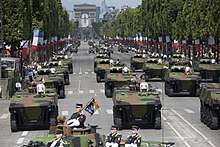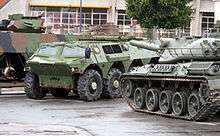Véhicule blindé de combat d'infanterie
The Véhicule Blindé de Combat d'Infanterie (VBCI, "Armoured Infantry Fighting Vehicle") is a French Infantry fighting vehicle designed to replace the AMX-10P.[4] They entered active service with the French Army in 2008, with 630 vehicles ordered up to 2010. Spain[3] and the UK[5] have shown interest in the vehicle.
| VBCI | |
|---|---|
A VBCI registered '6094 0048', OURCQ 1918 | |
| Type | Infantry fighting vehicle |
| Place of origin | France |
| Service history | |
| Wars | War in Afghanistan Operation Serval |
| Production history | |
| Manufacturer | Giat Industries / Renault VI |
| Unit cost | €3.49m[1] (VCI, FY2012) €2.74m[1] (VPC, FY2012) |
| Produced | 2008-2015 (planned) |
| No. built | 510 VCI, 120 VPC (planned) |
| Specifications | |
| Mass | VCI: 28.5 t (normal combat load). VPC: 28.5 t (normal combat load). |
| Length | 7.6 m |
| Width | 2.98 m |
| Height | 3 m |
| Crew | 3 + 8-man combat team |
| Armour | Protection against 14.5 mm API[2] |
Main armament | Canon mitrailleur GIAT modèle M811 NATO calibre 25 mm (400 rounds/ minute)[3] |
Secondary armament | co-axial 7.62 mm NATO machine gun |
| Engine | Renault Diesel 550 hp (410 kW) |
| Suspension | Wheel |
Operational range | 750 km (470 mi) |
| Maximum speed | 100 km/h (62 mph) |
The Véhicule Blindé de Combat d'Infanterie is built on an aluminium hull which carries a modular THD steel and titanium armour, which can be replaced in the field. The 8x8 wheel combination is designed to make the VBCI more comfortable and less costly than a tracked vehicle, while giving it sufficient mobility to back the Leclerc tank. The VBCI is also designed to be transportable by the Airbus A400M, with an empty mass less than 18 tonnes (full load mass up to 28 tonnes).
History


In the early 1990s, the French government started the VBM (Véhicule Blindé Modulaire — Modular Armoured Vehicle) as a replacement for its older IFVs. Soon, Germany and the United Kingdom joined the project. At Eurosatory 1996, Renault unveiled the X8A, an eight-wheeled prototype in this perspective.[6]
However, in 1999, the programme came to a dead-end, and France decided to carry on on its own and ordered 700 vehicles on 6 November 2000. In 2003–2004, the programme reached some major milestones: The mobility/agility tests, the armour tests and the electronic systems tests were all successful. From 2004 to 2005, the first 5 prototypes (4 VCIs and 1 VPC) were tested in real conditions. These tests proved some crucial design mistakes on the DRAGAR turret, which had to be redesigned. The 2 years delay in the programme are consequences of this design flaw.
As the programme reaches completion, other variants are being studied. A mortar version and a vehicle using the MILAN Missile have been considered by the developer. Note that none of these variants are being developed as of now, but feasibility studies are being conducted. In June 2007, VBCI was being considered for the British FRES programme.[7]
France originally planned to buy 550 VCI and 150 of the VPC command version, but this was cut to 510 and 120 respectively with deliveries until 2015.[1] The €3.49bn (FY2012) project will deliver 630 units at a unit cost of €3.49m (~US$4.8m) for the VCI and €2.74m (~US$3.7m) for the VPC, or €5.5m (~US$7.4m) per vehicle including development costs.[1]
The 200th VBCI was delivered to the French army on 23 June 2010.[8] The 400th VBCI was delivered to the French army on 12 June 2012.[9] The first unit to be equipped with the new infantry fighting vehicle was the 35th Infantry Regiment in Belfort.[10] The 500th VBCI was delivered to the French Army on 8 July 2013. Delivery of 110 command post vehicles has been completed.[11]
At Eurosatory 2014, Nexter unveiled improvements to the VBCI IFV variant following trials. The rear wheels have steering to reduce its turning radius to 20 meters, and rear internal volume was increased by moving electrical equipment to the front of the vehicle. To make room for the equipment, the driver's seat was pulled back and two sloping angles were added to the front end for the driver to maintain visibility.[12] In September 2014, the French Army Procurement Agency (DGA) declared the qualification of a new version of the VBCI with a 32-ton gross vehicle weight, compared to 29 tons previously. The increase in gross weight allows the vehicle to have better protection and preserves its capability to be upgraded.[13] The 32-ton configuration will be delivered to the French armed forces starting in 2015.[14]
Export
United Kingdom
In July 2014, France agreed to loan 19 VBCIs to the British Army for testing.[15] The British Army was reportedly interested in the vehicle for its Mechanised Infantry Vehicle program.[16][17] In February 2014, it was reported that the French Army may purchase the British Watchkeeper WK450 unmanned aerial vehicle if the British Army bought the VBCI.[18] However, in November 2019, the British Army confirmed its selection of Boxer for its MIV program.[19]
Qatar
In December 2017, during a visit by French President Emmanuel Macron, Qatar announced it intended to purchase 490 Nexter VBCI vehicles.[20][21] Negotiations continue to be under way for the exact loadout of the 490 vehicles, with American, British, French, Norwegian and Belgian firms bidding for turret systems among other systems.[22]
In March 2018, it was reported Kongsberg would supply unmanned medium-calibre turrets and Protector remote weapons stations in the event that Qatar ordered the VBCIs in a contract worth up to US$1.94 billion.[23]
Specifications
C4ISR
The VBCI will be completely integrated in the French C4ISR capability. The VCI version will use the SIT (Système d’Information Terminal — The lowest level of C4IST in the French forces), while the VPC will use the SIR (Système d’Information Régimentaire — A higher level in the same system).
The vehicle will be designed to primarily carry soldiers equipped with the FÉLIN system.
DRAGAR Turret
The DRAGAR Turret (GIAT INDUSTRIES) is a single seat modular design turret integrating a 25 mm stabilized gun. Fire control integrates a laser rangefinder and a thermal camera. The rate of fire is up to 400 rounds/min, and the turret allows anti-air self-defence. It also includes a coaxial 7.62 mm machine gun for close defence and a Galix grenade launching system. The turret adds 2,000 kilograms (4,400 lb) to a vehicle's weight.[24]
Variants
- VCI (infantry combat vehicle): Combat group of 9 men (+ crew), medium calibre Dragar type turret (25 mm), 7.62 mm machine gun.
- VPC (command post vehicle): 2 SIP stations with 7 users (+ crew), self-defence turret armed with a 12.7 mm machine gun.
- VTT (Troop Transport Vehicle): It is designed to transport troops. It has an interior volume of 13 m³ and can carry a 2-man crew and up to 10 soldiers with their equipment. The VTT is sized to meet export requirements and is currently being considered by several national armies.
Common features for all variants include SIT (Système d’Information Terminal) communication equipment, combat identification equipment, and NBC detection and protection equipment.
VBCI 2
The VBCI 2 is an improved version, intended for export sales, with new engine (600 hp Volvo D13 turbocharged diesel engine), new air conditioner, and new vision cameras. It is heavier (32 t) and the prototype is equipped with a T40 two-man turret (40mm gun).[25][26]
References
- "Projet de loi de finances pour 2013 : Défense : équipement des forces" (in French). Senate of France. 22 November 2012. Archived from the original on 26 March 2013. Retrieved 7 November 2013.
- "Dossier : VBCI" (PDF). Archived from the original (PDF) on 23 July 2011. Retrieved 3 November 2010.
- "GTD y NEXTER Systems firman un acuerdo de colaboración para el desarrollo del Futuro Vehículo Blindado 8x8". Archived from the original on 24 May 2009. Retrieved 18 September 2009.
- Jane's international defense review: IDR., Volume 37, Issues 1-6. Jane's Information Group. 2004. Retrieved 14 February 2011.
It had therefore confined itself to wheeled vehicles in the VBM program and concentrated after 1996 on the development of a single 8x8 IFV, the Vehicule Blinde de Combat d'Infanterie (VBCI).
- David Cameron: UK and France 'as close as ever'
- 1996 RENAULT X8A Archived 4 March 2016 at the Wayback Machine, chars-francais.net
- "Drayson: New vehicles will have "vital part to play in the Army of the future"". Archived from the original on 11 July 2007. Retrieved 23 December 2008.
- "The DGA delivers the 200th VBCI to the French Army". defpro. 2010. Archived from the original on 25 March 2012. Retrieved 16 June 2010.
- "400 VBCI et un millier de PVP livrés à l'armée de Terre". Meretmarine. 2012. Retrieved 14 June 2012.
- (in French) Présentation de la formation "VBCI" au 35e régiment d'infanterie.
- French army takes delivery of the 500th VBCI 8x8 armoured infantry fighting vehicle Archived 7 October 2013 at the Wayback Machine - Armyrecognition.com, 8 July 2013
- Nexter modifies VBCI troop carrier Archived 15 July 2015 at the Wayback Machine - Shephardmedia.com, 18 June 2014
- French army procurement agency qualifies new 32 tons variant Nexter VBCI infantry fighting vehicle Archived 5 October 2014 at the Wayback Machine - Armyrecognition.com, 2 October 2014
- French Defense Procurement Agency Qualifies the 32 Tons VBCI Armored Vehicle Archived 6 October 2014 at the Wayback Machine - Deagel.com, 2 October 2014
- "19 VBCI et 2 CAESAR mis à disposition de la British Army, sur le sol français, pour six mois". Ouest France. 4 July 2014.
- UK; Army to field test French VBCI AFV Archived 1 March 2014 at the Wayback Machine - Dmilt.com, 24 February 2014
- British Army could be interested to purchase Nexter VBCI 8x8 armoured infantry fighting vehicle Archived 3 March 2014 at the Wayback Machine - Armyrecognition.com, 2 February 2014
- France negotiates acquisition of Watchkeeper drones against purchase of VBCI armoured by UK Archived 14 July 2015 at the Wayback Machine - Armyrecognition.com, 20 February 2014
- "BOXER for the British Army". British Army. 5 November 2019.
- Lamigeon, Vincent (7 December 2017). "Rafale, blindés VBCI : le Qatar, nouveau paradis des vendeurs d'armes français". Challenges (in French). Archived from the original on 26 December 2017. Retrieved 26 December 2017.
- Blandin, Laetitia (19 December 2017). "VBCI sets new major milestones in Qatar". Nexter Group. Versailles-Satory. Archived from the original on 26 December 2017. Retrieved 26 December 2017.
- Tran, Pierre (11 December 2017). "Qatar to negotiate with Nexter for armored vehicles, add-ons". Defense News. Paris. Archived from the original on 26 December 2017. Retrieved 26 December 2017.
- Bingham, James (13 March 2018). "DIMDEX 2018: Kongsberg selected for Qatari VBCI turrets". IHS Jane's 360. London. Archived from the original on 14 March 2018. Retrieved 15 March 2018.
- David R. Gillingham, Prashant R. Patel. "Method of Estimating the Principal Characteristics of an Infantry Fighting Vehicle from Basic Performance Requirements" (PDF). INSTITUTE FOR DEFENSE ANALYSES. p. 35. Archived (PDF) from the original on 29 April 2019. Retrieved 28 April 2019.CS1 maint: uses authors parameter (link)
- Foss, Christopher F. (15 September 2015). "DSEI 2015: Nexter Systems pins export hopes on VBCI-2". IHS Jane's Defence Weekly. Archived from the original on 17 September 2015.
- "VBCI 2". military-today.com. Archived from the original on 31 March 2019. Retrieved 31 March 2019.
External links
| Wikimedia Commons has media related to Véhicule Blindé de Combat d'Infanterie. |